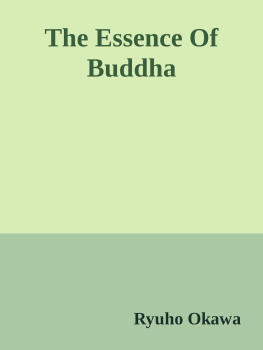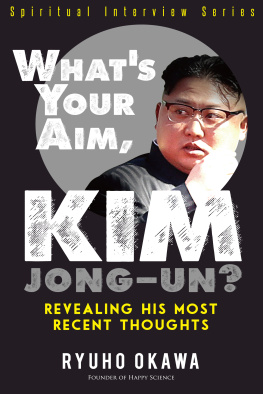THE
ESSENCE OF
BUDDHA
The Path to Enlightenment
RYUHO OKAWA
JAICO PUBLISHING HOUSE
Ahmedabad Bangalore Bhopal Bhubaneswar Chennai Delhi Hyderabad Kolkata Lucknow Mumbai
Published by Jaico Publishing House
A-2 Jash Chambers, 7-A Sir Phirozshah Mehta Road
Fort, Mumbai - 400 001
www.jaicobooks.com
Ryuho Okawa
English translation Happy Science
First published as Shaka-no-Honshin by Happy Science
All Rights Reserved.
Published in arrangement with
IRH Press Co. Ltd.
2-10-14, Akasaka, Minato-ku
Tokyo 107-0052, Japan
THE ESSENCE OF BUDDHA
ISBN 978-81-7992-786-1
First Jaico Impression: 2008
First Jaico Impression: 2011
No part of this book may be reproduced or utilized in any form or by any means, electronic or mechanical including photocopying, recording or by any information storage and retrieval system, without permission in writing from the publishers.
Contents
The Enlightenment Under The Bodhi Tree
The Discovery of the Noble Eightfold Path
The Six Paramitas
The Idea of the Void
The Law of Causality
The Philosophy of Human Perfection
Preface to the First Japanese Edition
It gives me great pleasure to publish this book, The Essence of Buddha . The first chapter tells the story of how Shakyamuni renounced the secular life and attained the great enlightenment; then, in the following chapters, I have explained in a modern and systematic way the very essence of the laws he taught. I intend to offer a complete account of Shakyamunis life at some other time, but in the meantime in this volume I have presented an overview of his thought. I trust that you will find a clear picture of the basic framework of Shakyamuni Buddhas thought. The main ideas such as the Noble Eightfold Path, the Six Paramitas, the Void and the Law of Causality are explained in such a way that it will be easy even for a reader who has little previous knowledge of Buddhism to understand.
I hope that this book which, like The Laws of the Sun, The Golden Laws and The Laws of Eternity , came into being through spiritual revelation will nourish the hearts and minds of many.
Ryuho Okawa, August 1988
CHAPTER ONE
The Enlightenment Under the Bodhi Tree
The Renunciation of a Secular Life
I n this book, I would like to explore what was really in the mind of Gautama Siddhartha, who later became known as Shakyamuni Buddha or simply the Buddha, to focus on his enlightenment and what he did after. For this reason, rather than giving extensive background information, I will attempt to describe how Gautama attained enlightenment after he renounced his secular life as a prince, how he lived out his long years of teaching the Truth to the public, with emphasis on what he thought during that period from the point of view of his innermost self. Much Buddhist literature has already described his renunciation of the secular life, and I would say that the contents of those texts are mostly correct.
There were three main reasons why Gautama renounced the secular life. The first was an inner voice that urged him to do this. He heard it say that in life at the royal palace he could not fulfil his yearning, and that something greater, something unknown was awaiting him. If I attempt to explain his feelings in the context of modern society, he could be likened to an ambitious youth who leaves his rural hometown to achieve something big and distinguish himself in the world. Rather, it might be more accurate to attribute this inner prompting to his innate nature, or foreknowledge of his calling.
The second reason is often described in various Buddhist traditions as Gautamas search for an answer to the questions of the Four Pains, the pains of birth, of aging, of illness, and of death. A well-known allegory goes like this: There were four gates at the Kapilavastu palace. When he went out of the east gate, he met an old man who looked haggard. Going out of the south gate he met someone suffering from illness, at the west gate, he saw someone who was sick and dying, and at the north gate he met an ascetic who had renounced the secular life. According to legend, it was only after encountering those four people that he began to wonder why people suffer the Four Pains of birth, aging, illness and death. However, it would have been practically impossible for him not to have been aware of human suffering until the age of twentynine. In actual fact, the real reason for his renunciation was different.
The palace of Kapilavastu, which was Gautamas home, had a custom of inviting men of religion to give lectures once a month. Just as it is the custom of the present Japanese Imperial Family to invite scholars to deliver lectures, so too the Royal Palace in ancient India one day invited a man who had attained a certain level of enlightenment to come and speak, so that they could learn from him.
Together with other members of the royal family, Gautama would listen to the talks of those religious teachers. Although the people around him were deeply impressed, he was unable to find answers to his inner questions. He had a strong philosophical urge to know what it was that those people were actually pursuing, what enlightenment really was. The second reason for his renunciation of the secular life was an inner prompting to search for answers to the questions he had about the words of the religious masters who had been invited to the palace.
The third reason was his strong desire to be alone, to remain absorbed in contemplation. Gautama had a highly meditative nature; from early teenage years, he was fond of contemplating in solitude. However, the social customs of that time required that the prince marry, and formal wedding ceremonies were held for him. He actually had four wives: in order of social status, Yashodhara was the most exalted, then came Gopa, followed by Manodhara, and a beautiful concubine, Murgaja, who had been a lady-in-waiting.
The reasons for the custom of polygamy in the royal family at that time can be explained as follows: 1) to increase the chances of securing a royal heir; 2) to provide a choice of more than one palace as a domicile, each with a wife, to lessen the risk of an enemy attack on the king (prince); 3) to reduce the risk of the overbearing influence of one particular wife on the government of the state; 4) to demonstrate royal dignity.
Gautama first took the beautiful Gopa as a wife, then he married the exalted and aristocratic Yashodhara as his first lady. She later withdrew from the world to become a nun, following the path of her son Rahula, Gautamas only heir who had become a monk.
Talking with his wives, Gautama could not help wondering why women were unromantic and liked to gossip so much. He became very tired of the jealousy and possessiveness they exhibited. In this sort of environment, it was extremely difficult for him to practise meditation or enjoy philosophical contemplation. Gradually, he developed a craving to be alone.
To be fair to the four wives of Gautama, however, I would like to add that they were all clever and beautiful women, suitable wives for a future king. If Gautama were to succeed his father to the throne and govern the country, as was expected, there would have been no problem. The truth is that there was no woman who could match his philosophical genius.

















